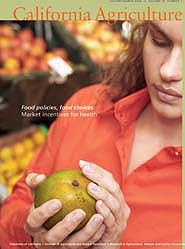All Issues

Food policies, food choices: Market incentives for health
Cover:
With rates of obesity and nutrition-related diseases skyrocketing, scientists and policy experts have proposed agricultural policies that would encourage consumers to make healthier food choices. In this issue, a panel of experts debate's diversified agriculture with its hundreds of specialty crops (page 5), and a policy analyst argues for market incentives to encourage better nutrition among food stamp recipients (page 8).
January-March 2006
Volume 60, Number 1
Volume 60, Number 1





